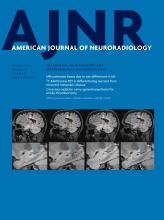Research ArticleAdult Brain
Open Access
Volumetric Analysis from a Harmonized Multisite Brain MRI Study of a Single Subject with Multiple Sclerosis
R.T. Shinohara, J. Oh, G. Nair, P.A. Calabresi, C. Davatzikos, J. Doshi, R.G. Henry, G. Kim, K.A. Linn, N. Papinutto, D. Pelletier, D.L. Pham, D.S. Reich, W. Rooney, S. Roy, W. Stern, S. Tummala, F. Yousuf, A. Zhu, N.L. Sicotte, R. Bakshi and the NAIMS Cooperative
American Journal of Neuroradiology August 2017, 38 (8) 1501-1509; DOI: https://doi.org/10.3174/ajnr.A5254
R.T. Shinohara
aFrom the Departments of Biostatistics and Epidemiology (R.T.S., K.A.L.)
J. Oh
cDepartment of Neurology (J.O., P.A.C., D.S.R.), Johns Hopkins University School of Medicine, Baltimore, Maryland
dSt. Michael's Hospital (J.O.), University of Toronto, Toronto, Ontario, Canada
G. Nair
eTranslational Neuroradiology Section (G.N., D.S.R.), National Institute of Neurological Disorders and Stroke, National Institutes of Health, Bethesda, Maryland
P.A. Calabresi
cDepartment of Neurology (J.O., P.A.C., D.S.R.), Johns Hopkins University School of Medicine, Baltimore, Maryland
C. Davatzikos
bRadiology (C.D., J.D.), Perelman School of Medicine, University of Pennsylvania, Philadelphia, Pennsylvania
J. Doshi
bRadiology (C.D., J.D.), Perelman School of Medicine, University of Pennsylvania, Philadelphia, Pennsylvania
R.G. Henry
fDepartment of Neurology (R.G.H., N.P., W.S., A.Z.), University of California, San Francisco, San Francisco, California
G. Kim
gLaboratory for Neuroimaging Research (G.K., S.T., F.Y., R.B.), Partners Multiple Sclerosis Center
K.A. Linn
aFrom the Departments of Biostatistics and Epidemiology (R.T.S., K.A.L.)
N. Papinutto
fDepartment of Neurology (R.G.H., N.P., W.S., A.Z.), University of California, San Francisco, San Francisco, California
D. Pelletier
iDepartment of Neurology (D.P.), Yale Medical School, New Haven, Connecticut
D.L. Pham
jHenry M. Jackson Foundation for the Advancement of Military Medicine (D.L.P., S.R.), Bethesda, Maryland
D.S. Reich
cDepartment of Neurology (J.O., P.A.C., D.S.R.), Johns Hopkins University School of Medicine, Baltimore, Maryland
eTranslational Neuroradiology Section (G.N., D.S.R.), National Institute of Neurological Disorders and Stroke, National Institutes of Health, Bethesda, Maryland
W. Rooney
kAdvanced Imaging Research Center, Oregon Health & Science University (W.R.), Portland, Oregon
S. Roy
jHenry M. Jackson Foundation for the Advancement of Military Medicine (D.L.P., S.R.), Bethesda, Maryland
W. Stern
fDepartment of Neurology (R.G.H., N.P., W.S., A.Z.), University of California, San Francisco, San Francisco, California
S. Tummala
gLaboratory for Neuroimaging Research (G.K., S.T., F.Y., R.B.), Partners Multiple Sclerosis Center
F. Yousuf
gLaboratory for Neuroimaging Research (G.K., S.T., F.Y., R.B.), Partners Multiple Sclerosis Center
A. Zhu
fDepartment of Neurology (R.G.H., N.P., W.S., A.Z.), University of California, San Francisco, San Francisco, California
N.L. Sicotte
lDepartment of Neurology (N.L.S.), Cedars-Sinai Medical Center, Los Angeles, California
R. Bakshi
gLaboratory for Neuroimaging Research (G.K., S.T., F.Y., R.B.), Partners Multiple Sclerosis Center
hDepartments of Neurology and Radiology (R.B.), Brigham and Women's Hospital, Harvard Medical School, Boston, Massachusetts
ma complete list of the NAIMS participants is provided in the “Acknowledgments.”

Submit a Response to This Article
Jump to comment:
No eLetters have been published for this article.
In this issue
American Journal of Neuroradiology
Vol. 38, Issue 8
1 Aug 2017
Advertisement
R.T. Shinohara, J. Oh, G. Nair, P.A. Calabresi, C. Davatzikos, J. Doshi, R.G. Henry, G. Kim, K.A. Linn, N. Papinutto, D. Pelletier, D.L. Pham, D.S. Reich, W. Rooney, S. Roy, W. Stern, S. Tummala, F. Yousuf, A. Zhu, N.L. Sicotte, R. Bakshi, the NAIMS Cooperative
Volumetric Analysis from a Harmonized Multisite Brain MRI Study of a Single Subject with Multiple Sclerosis
American Journal of Neuroradiology Aug 2017, 38 (8) 1501-1509; DOI: 10.3174/ajnr.A5254
Volumetric Analysis from a Harmonized Multisite Brain MRI Study of a Single Subject with Multiple Sclerosis
R.T. Shinohara, J. Oh, G. Nair, P.A. Calabresi, C. Davatzikos, J. Doshi, R.G. Henry, G. Kim, K.A. Linn, N. Papinutto, D. Pelletier, D.L. Pham, D.S. Reich, W. Rooney, S. Roy, W. Stern, S. Tummala, F. Yousuf, A. Zhu, N.L. Sicotte, R. Bakshi, the NAIMS Cooperative
American Journal of Neuroradiology Aug 2017, 38 (8) 1501-1509; DOI: 10.3174/ajnr.A5254
Jump to section
Related Articles
Cited By...
- Short-term changes in objectively measured activity predict brain atrophy and disability progression in multiple sclerosis
- A preliminary attempt to harmonize using physics-constrained deep neural networks for multisite and multiscanner MRI datasets (PhyCHarm)
- Brain Charts for People Living with Multiple Sclerosis
- MISPEL: A supervised deep learning harmonization method for multi-scanner neuroimaging data
- Multiscale functional connectivity patterns of the aging brain learned from rsfMRI data of 4,259 individuals of the multi-cohort iSTAGING study
- Inter-scanner brain MRI volumetric biases persist even in a harmonized multi-subject study of multiple sclerosis
- Privacy-preserving harmonization via distributed ComBat
- Automatic quantification of brain lesion volume from post-trauma MR Images
- On stability of Canonical Correlation Analysis and Partial Least Squares with application to brain-behavior associations
- Integrating large-scale neuroimaging research datasets: harmonisation of white matter hyperintensity measurements across Whitehall and UK Biobank datasets
- Longitudinal ComBat: A Method for Harmonizing Longitudinal Multi-scanner Imaging Data
- Voxel-Based Morphometry--from Hype to Hope. A Study on Hippocampal Atrophy in Mesial Temporal Lobe Epilepsy
- Harmonization of large multi-site imaging datasets: Application to 10,232 MRIs for the analysis of imaging patterns of structural brain change throughout the lifespan
- The Canadian Biomarker Integration Network in Depression (CAN-BIND): magnetic resonance imaging protocols
- Intensity warping for multisite MRI harmonization
- BOLD signal variability and complexity in children and adolescents with and without autism spectrum disorder
- An automated statistical technique for counting distinct multiple sclerosis lesions can recover aspects of lesion history and provide relevant disease information
- Imaging outcome measures of neuroprotection and repair in MS: A consensus statement from NAIMS
- An Automated Statistical Technique for Counting Distinct Multiple Sclerosis Lesions
This article has not yet been cited by articles in journals that are participating in Crossref Cited-by Linking.
More in this TOC Section
Similar Articles
Advertisement











